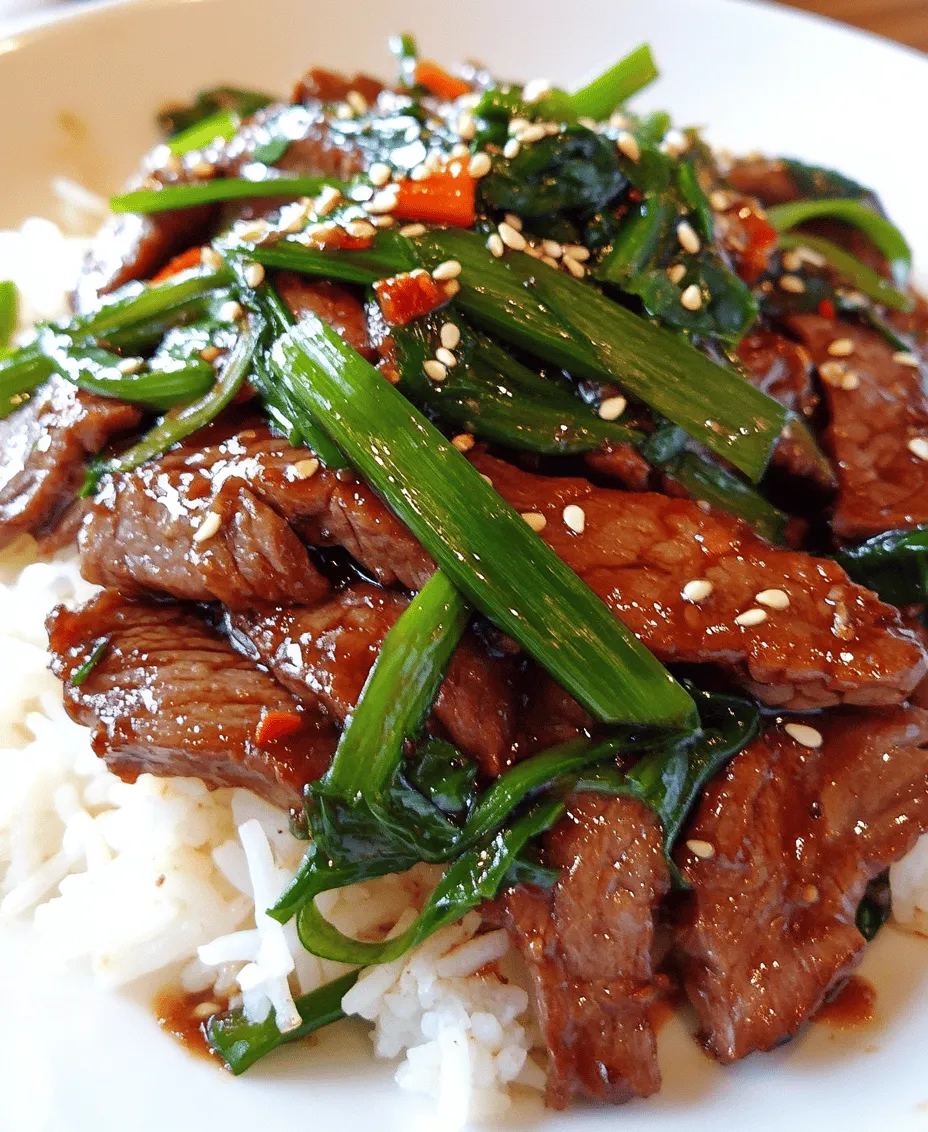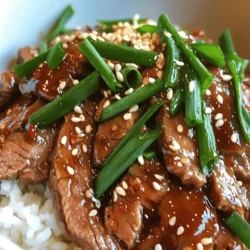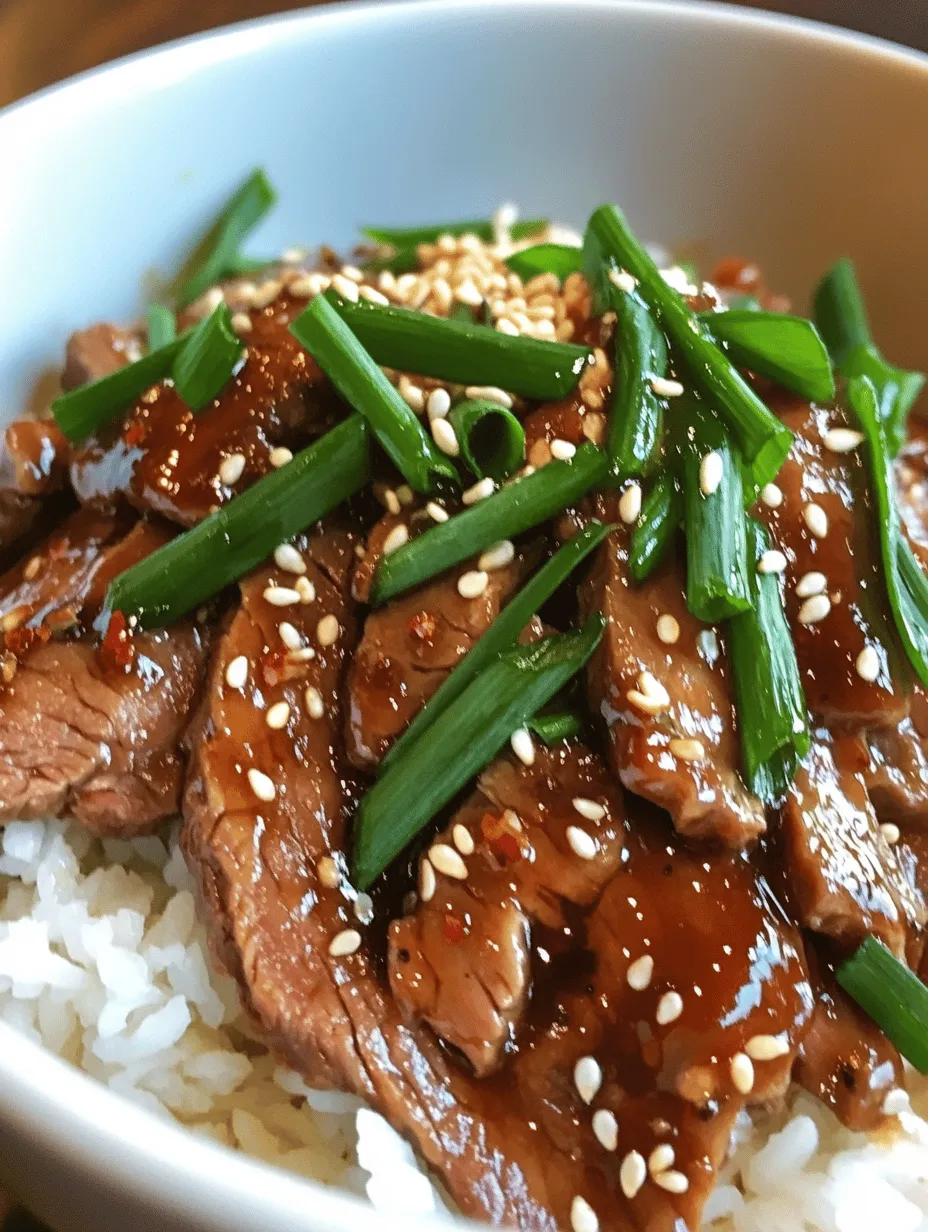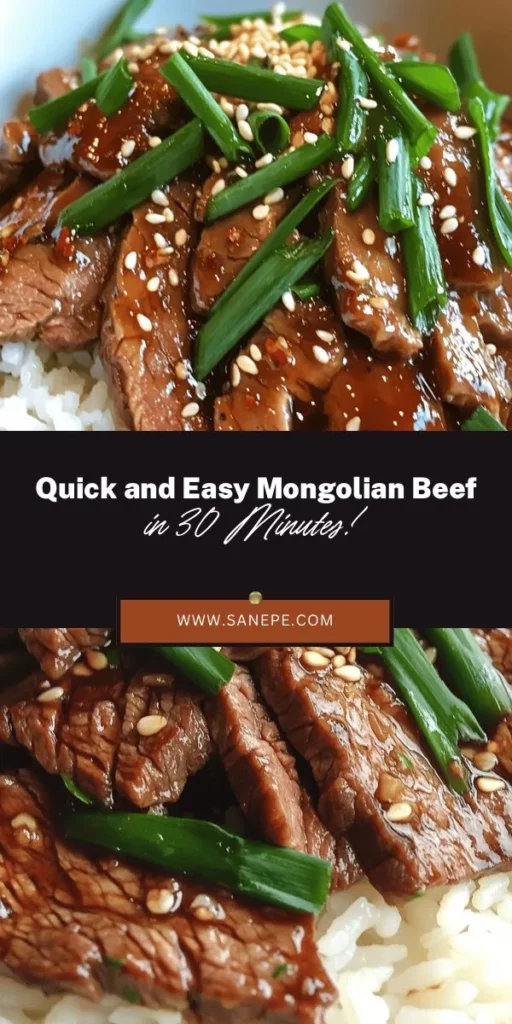Introduction
Mongolian beef is a beloved dish that has captured the hearts of many food enthusiasts around the world. Often found on menus in Asian restaurants, this dish features tender slices of beef stir-fried with a rich, flavorful sauce. Its origins are somewhat murky, as it does not strictly represent traditional Mongolian cuisine but rather embodies a fusion of flavors enjoyed in Chinese-American cooking. Despite its name, Mongolian beef is more about the delectable combination of sweet and savory elements than an authentic representation of Mongolia’s culinary landscape.
What makes Mongolian beef particularly appealing to home cooks is its simplicity and the relatively quick preparation time involved. With just a handful of ingredients, you can create a dish that feels gourmet while being entirely feasible for a busy weeknight dinner. This recipe takes less than 30 minutes from start to finish, making it an excellent option for those who seek delicious meals without spending hours in the kitchen. Whether you’re serving it over rice or noodles, this easy Mongolian beef is sure to impress your family and friends.
Understanding the Ingredients
To create a mouthwatering Mongolian beef dish, understanding the role of each ingredient is essential. Here’s a closer look at the key components that contribute to the dish’s rich flavor and satisfying texture.
Flank Steak
The star of this dish is undoubtedly the beef, and flank steak is the best choice for achieving that perfect balance of tenderness and flavor. This cut comes from the abdominal muscles of the cow and is known for its lean profile and robust beefy taste. When prepared correctly, flank steak offers a deliciously chewy texture that absorbs sauces beautifully. To ensure the best results, it is crucial to slice the beef against the grain into thin strips. This technique helps to break down the muscle fibers, resulting in a tender bite that melts in your mouth.
Cornstarch
Cornstarch plays a vital role in this recipe by creating a crispy coating on the beef. When tossed with cornstarch, the surface of the meat becomes slightly sticky, allowing it to sear beautifully in the hot pan. This not only enhances the texture but also aids in creating a flavorful crust that locks in juices. The cornstarch also thickens the sauce slightly, giving it a luscious consistency that clings to the beef and vegetables.
Vegetable Oil
Choosing the right oil for cooking is crucial, especially for stir-frying, where high temperatures are involved. Vegetable oil, or any oil with a high smoke point, is recommended for this recipe. This ensures that the beef can be seared quickly without the oil burning or affecting the flavor. Oils such as canola, grapeseed, or peanut oil work wonderfully, allowing you to achieve that coveted crispy exterior while keeping the beef tender and juicy.
Aromatics: Green Onions, Garlic, and Ginger
Aromatics are the unsung heroes of many dishes, and in Mongolian beef, green onions, garlic, and ginger provide a fragrant foundation for the recipe. Green onions add a mild onion flavor and a pop of color, while garlic and ginger introduce warmth and depth. Together, these ingredients create a tantalizing aroma that fills your kitchen, making it hard to resist the allure of this dish. When sautéed, they release essential oils that enhance the overall flavor profile, making every bite a delightful experience.
Soy Sauce and Brown Sugar
The sauce is where the magic happens, and the combination of soy sauce and brown sugar is key to achieving the perfect balance of sweet and savory. Soy sauce provides that umami richness, while brown sugar adds a hint of sweetness that complements the saltiness of the soy. This dynamic duo creates a sauce that coats the beef beautifully, providing both flavor and a glossy finish. The sweetness of the brown sugar also helps to counterbalance the saltiness of the soy sauce, creating a harmonious blend that elevates the dish.
Red Pepper Flakes
If you enjoy a touch of heat in your meals, red pepper flakes can easily be incorporated into the sauce. This optional ingredient adds a spicy kick that contrasts beautifully with the sweetness of the sauce. Adjust the amount according to your heat tolerance; a pinch can elevate the dish, while too much may overpower the other flavors.
Ingredient Substitutions and Variations
Mongolian beef is versatile, and you can make adjustments to suit your taste or dietary needs. If flank steak is unavailable, other cuts like sirloin or ribeye can be used, although they may require different cooking times. For a lighter version, consider using chicken or tofu as a substitute for beef. In terms of sauces, you can experiment with low-sodium soy sauce for a healthier option or use coconut aminos for a gluten-free alternative. Additionally, feel free to add vegetables like bell peppers, broccoli, or snap peas to incorporate more nutrients and color into the dish.
Step-by-Step Instructions
Now that we’ve covered the essential ingredients, let’s dive into the preparation of this easy Mongolian beef recipe. Follow these detailed steps to create a dish that impresses with its flavor and simplicity.
Preparing the Beef with Cornstarch
1. Slice the Flank Steak: Start by placing the flank steak on a cutting board. Using a sharp knife, slice the meat against the grain into thin strips, about 1/4 inch thick. This technique is crucial for ensuring that the beef remains tender after cooking.
2. Coat the Beef: In a mixing bowl, add the sliced beef and sprinkle about 1/4 cup of cornstarch over it. Toss the beef until each piece is evenly coated in the cornstarch. This step not only helps to create a crispy texture but also acts as a protective layer during cooking, keeping the meat moist.
Heating and Cooking Techniques
3. Preheat the Pan: Heat a large skillet or wok over medium-high heat. Allow it to get hot before adding oil; this will ensure that the beef sears rather than steams.
4. Sear the Beef: Once the pan is hot, pour in about two tablespoons of vegetable oil. Swirl the oil around to coat the surface of the pan. Add the cornstarch-coated beef in a single layer, being careful not to overcrowd the pan. You may need to cook the beef in batches if your skillet is not large enough. Sear the beef for about 2-3 minutes without stirring, allowing it to develop a golden-brown crust.
5. Flip and Cook: After the initial sear, use tongs to flip the beef and cook for another 1-2 minutes until it is browned and just cooked through. Remove the beef from the pan and set it aside on a plate.
Sautéing Aromatics
6. Sauté the Aromatics: In the same skillet, add a little more oil if necessary, then throw in the minced garlic and ginger. Cook for about 30 seconds or until fragrant, being careful not to let them burn. The aroma will fill the kitchen and signal that it’s time to add the next ingredients.
Creating the Sauce
7. Prepare the Sauce: In a separate bowl, combine 1/2 cup of soy sauce, 1/4 cup of brown sugar, and the optional red pepper flakes. Stir until the sugar dissolves. This mixture will serve as the savory-sweet sauce that ties the dish together.
8. Combine Ingredients: Return the seared beef to the skillet along with the sautéed garlic and ginger. Pour the sauce over the beef and stir everything together to ensure that the meat is evenly coated. Allow the mixture to simmer for about 2-3 minutes, enabling the sauce to thicken slightly and infuse the beef with flavor.
With these steps, you’re well on your way to creating a delicious plate of easy Mongolian beef that will tantalize your taste buds. Stay tuned for the final touches and serving suggestions that will elevate your meal to the next level!

Serving Suggestions
When it comes to serving Mongolian beef, presentation can elevate this dish from everyday to extraordinary. Here are some ideas to serve your Mongolian beef in an aesthetically pleasing manner:
– Plate It Beautifully: Start with a white or neutral-colored plate to make the rich, dark color of the beef stand out. Use a ring mold to stack the beef and sauce, garnishing with finely chopped green onions for a pop of color.
– Garnish Creatively: Fresh herbs can enhance the visual appeal and flavor. Consider adding sprigs of cilantro or additional slices of green onion on top just before serving. A sprinkle of sesame seeds can also add a nice crunch and a gourmet touch.
– Accompanying Dishes: For a well-rounded meal, serve your Mongolian beef with steamed jasmine rice or fluffy basmati rice. If you want to keep things lighter, consider cauliflower rice or zucchini noodles as a low-carb alternative.
– Vegetable Sides: Pair the beef with sautéed or steamed vegetables. Broccoli, bell peppers, or snap peas not only complement the dish’s flavors but also add a vibrant mix of colors. A simple stir-fry of these vegetables in soy sauce and garlic can provide both nutrition and visual appeal.
– Family Style Serving: If you’re hosting a dinner, consider serving the Mongolian beef in a large bowl in the center of the table, allowing everyone to help themselves. Provide individual bowls of rice or vegetable sides for guests to customize their plates.
Nutritional Information
Understanding the nutritional content of your Mongolian beef can help you make informed choices, especially if you’re watching your diet. Here’s a general breakdown of the nutritional information per serving:
– Calories: Approximately 300-400 calories depending on portion size and cooking method.
– Protein: About 25-30 grams, making it a great source of lean protein.
– Fat: Roughly 15-20 grams, primarily from the cooking oil and beef.
– Carbohydrates: Around 10-15 grams, mostly from the sauce and any added sugars.
– Sugars: 6-8 grams, which come from the sauce ingredients.
Health Aspects of Ingredients
The primary ingredients in Mongolian beef, such as flank steak, soy sauce, and green onions, offer various health benefits:
– Flank Steak: A lean cut of beef rich in protein, iron, and B vitamins, essential for muscle growth and energy metabolism.
– Soy Sauce: While adding flavor, it can be high in sodium. Opt for low-sodium soy sauce to reduce salt intake.
– Green Onions: These add flavor without many calories and are a good source of vitamins A, C, and K.
Dietary Considerations
For those with dietary restrictions, Mongolian beef can be easily modified. Here are some alternatives:
– Gluten-Free: Substitute traditional soy sauce with tamari or a gluten-free soy sauce alternative. This keeps the dish flavorful while catering to gluten sensitivities.
– Lower Carb Options: As mentioned earlier, using cauliflower rice or other vegetables instead of rice can be beneficial for those on low-carb diets.
Cultural Context
Mongolian beef, while named after Mongolia, is not a traditional dish from the country itself. Instead, it has roots in Chinese-American cuisine and has become a staple in many Chinese restaurants across the globe. The dish is believed to have been inspired by the flavors of Mongolian-style barbecue, which emphasizes grilled meats and aromatic sauces.
Evolution in Western Cuisine
Over time, Mongolian beef has adapted to fit Western palates. The original focus on simple, hearty flavors has been enhanced with more pronounced sweet and savory notes, making it a favorite for those seeking bold tastes. This adaptability has allowed it to become a common feature on takeout menus and in home kitchens alike.
Comparison to Other Asian Dishes
Mongolian beef shares similarities with other popular Asian dishes, such as beef teriyaki and stir-fried beef with broccoli. However, the distinct sweet and savory sauce, along with the use of flank steak, sets it apart. The sauce typically contains a balance of soy sauce, sugar, and garlic, which is reminiscent of the flavors found in teriyaki but with a heartier texture and more robust taste.
Tips for Success
To ensure your Mongolian beef turns out perfectly every time, keep these tips in mind:
– Avoid Common Mistakes: One of the most common mistakes when making Mongolian beef is overcooking the meat. Flank steak should be stir-fried quickly over high heat to keep it tender. Aim for a quick sear rather than prolonged cooking.
– Quality Ingredients: The quality of your beef can significantly impact the final dish. Look for fresh, grass-fed flank steak for the best flavor and texture. Freshly minced garlic and ginger also enhance overall taste.
– Meal Prep and Storage: If you’re prepping ahead, marinate the beef for at least 30 minutes or even overnight for deeper flavor. Cooked Mongolian beef can be stored in the refrigerator for up to 3 days. Reheat gently on the stovetop to maintain the texture.
Conclusion
Making Mongolian beef at home is not only satisfying but also incredibly simple, making it an ideal option for a quick weeknight dinner. The balance of sweet and savory flavors, combined with tender beef and fresh vegetables, creates a dish that’s both comforting and delicious.
With its versatility, Mongolian beef can easily adapt to various dietary preferences and ingredient substitutions, ensuring that everyone at the table can enjoy it. So why not gather your ingredients and try this easy Mongolian beef recipe? You might just find it becomes a staple in your culinary repertoire, perfect for impressing guests or treating your family to something special without much fuss. Enjoy the rich flavors and the joy of cooking this delicious dish!


